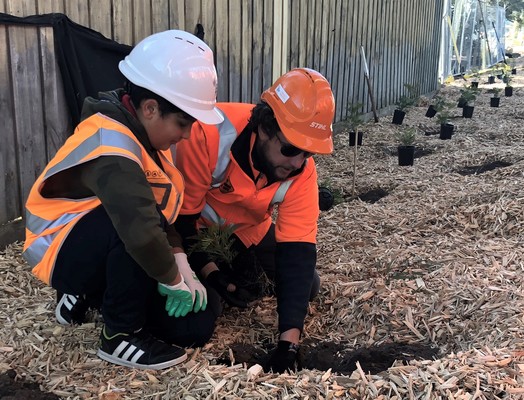By Cam Lucadou-Wells
The first new trees have been planted in Noble Park, replacing the stands of river red gums cleared as part of the Level Crossing Removal Project.
Noble Park Primary School students joined the replanting efforts on 24 July, including fast-growing ‘little spotty’ eucalypts.
About 12,000 trees, shrubs and plants are expected to be planted in Noble Park’s new public open spaces as a result of the rail-elevation project.
Three level crossings at Heatherton, Corrigan and Chandler roads, Noble Park were also removed.
A spokeswoman for the Level Crossing Removal Authority said most of the trees would be native, including the ‘little-spotty’ and ‘eucy dwarf’ gum trees and bird-attracting corymbias.
“To give them the best possible chance to thrive, trees will mostly be around two metres in height when planted.”
Resident Gaye Guest commented on Dandenong Star Journal’s Facebook page that this didn’t compensate for the loss of about 300 “heritage” river red gums up to 200 years old.
“Two years ago trees were cut down only to start being replaced with sapling stock this week.
“It’s appalling!”
Opposition public transport spokesman David Davis told Parliament on 25 July that the revegetation effort was “wholly inadequate”.
“They are tiny plantings in Noble Park and in other corridors as well — minute plants have been put there.
“What has happened is that hundreds and hundreds of trees have been clear-felled out of that corridor — some of them very large established trees.
“In fact in the Noble Park case old red gums were actually just knocked clear down by this Government.”
According to Greater Dandenong Council’s urban street tree strategy, there is a shortage of street trees, especially ones offering large shade.
The region’s estimated 55,000 street trees have a canopy coverage of about 9.9 per cent of the municipality – a low quantity by Melbourne council standards.
Noble Park (18 per cent) was ahead of the metropolitan average for tree canopy but southern Greater Dandenong suburbs lagged.
This is attributed to lopping of river red gum woodlands, the vast drained swampland and agricultural and industrial uses.
Over the next 10 years, the council aims to fill the 10,000 vacant tree sites in urban Greater Dandenong.
It hopes to increase tree canopy coverage by 15 per cent by 2028.
The benefits are filtering air pollution, higher property values, providing wildlife habitat, reducing stormwater runoff and reducing surface temperatures, the report stated.







